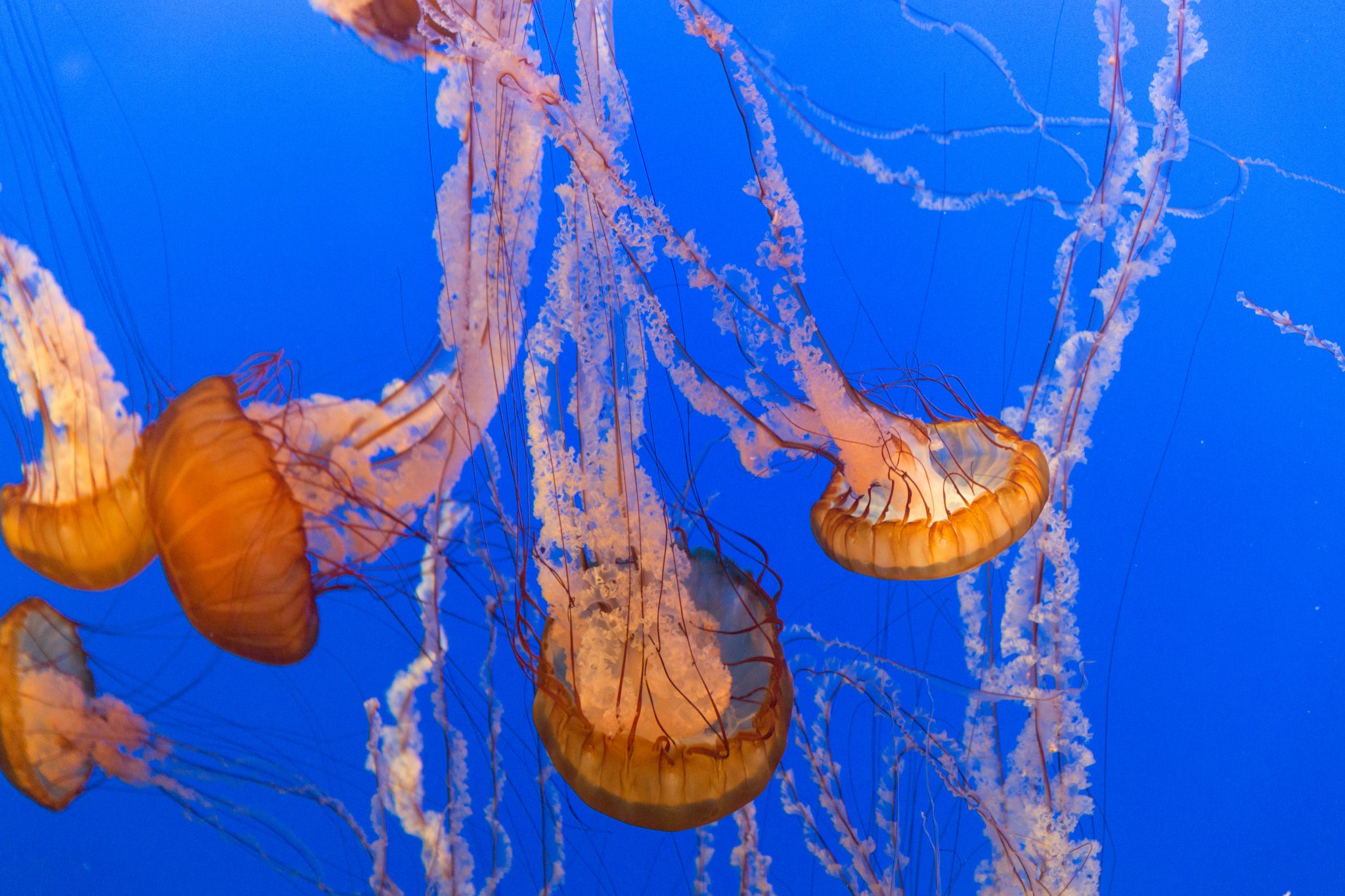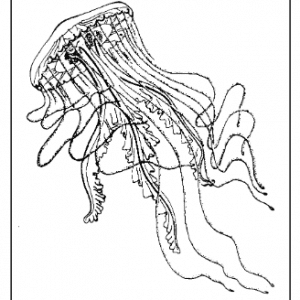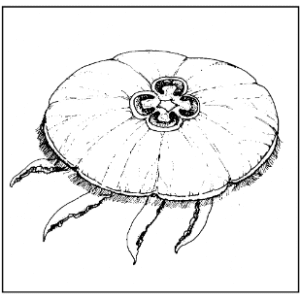Coastal Programs

Jellyfish are regular inhabitants of the saltwater bays, bayous, and Gulf beaches of Alabama. As many as sixty different kinds of jellyfish might be found in Alabama waters. However, only seven species are common: the sea nettle, moon jellyfish, cannonball, Portuguese man-of-war, oceanic jelly, sea wasp, and mushroom jelly.
Jellyfish belong to the large group of animals called coelenterates, which includes the little-known hydroids as well as the more familiar sea anemones and corals. The Portuguese man-of-war is technically a hydroid but is here included with the jellyfish for general discussion. Coelenterates have several unique characteristics, but the one of most interest to waders, swimmers, and anglers is the stinging cells found in most jellyfish.
Jellyfish Stingers
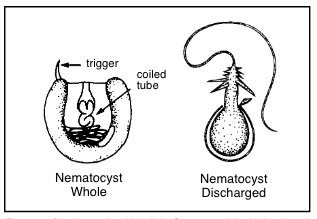
Figure 1. Stinging cells of jellyfish. (Courtesy of the University of Delaware Sea Grant College Program.)
Stinging cells (cnidoblasts) are concentrated in the tentacles but may be found on other parts of the jellyfish. The stinging cells contain a stinging structure (Figure 1) called a nematocyst. Nematocysts are often harpoon-like and are ejected from their cells when the cells are stimulated by touch or chemical signals. The harpoon is open at the tip, and upon penetration it delivers a protein toxin that paralyzes small fish and other prey. It is this toxin that produces the severe burning sensation when people come in contact with jellyfish.
Treating Stings
As with bee and wasp stings, the severity of reaction depends on the species of jellyfish and the person stung. Stings are best treated by the following procedures:
Do not rub the affected area, but attempt to flush any tentacles away from the skin using saltwater. Fresh water will stimulate the stinging cells to discharge.
Treat the affected area with isopropyl alcohol (40 to 70 percent) or vinegar to inactivate any remaining stinging cells.
Apply a paste of meat tenderizer, which is reported to denature the toxic proteins and thus relieve the pain.
Anyone who is stung should be closely observed for adverse reactions, including cardiac or respiratory problems or shock. Anyone stung over a large portion of the body should receive immediate medical attention.
Sea Nettles, Moon Jellies, and Cannonballs
The most common stinging jellyfish in our area is the sea nettle (Figure 2). The bell or umbrella of the sea nettle is typically 4 to 6 inches in diameter and has twenty-four tentacles and four ribbon-like oral arms. The umbrella and oral arms are sometimes pink but may be white. The tentacles and arms can extend several feet beyond the umbrella. Sea nettles are unusual among jellyfish in that they seem to prefer lower salinity water and are commonly found in waters with salinities of 7 to 25 parts per thousand (full-strength sea water has a salinity of 35 parts per thousand).
Another local jellyfish that is more often found in the open Gulf is the moon jelly (Figure 3). This jellyfish can be as much as 18 inches in diameterand is divided into eight equal parts and has numerous small tentacles. The middle of the umbrella has four horseshoe-shaped reproductive organs that range in color from pink to yellow to gray. Moon jellyfish are said to produce a milder stingthan other jellyfish. Small fish, particularly jacks, are often associated with the moon jelly.
Cannonball jellyfish (Figure 4) are also commonly found in Gulf waters. The bell is very firm, bordered with brown pigment, and usually 8 to 10 inches in diameter. This jellyfish is reputed to be one of the least venomous but at times causes problems for shrimp fishermen by clogging their nets. A swarm of cannonball jellyfish sited at Port Aransas, Texas, was estimated to be drifting through the pass at a rate of 2,000,000 individuals per hour.
- Figure 2. The sea nettle, Chrysaora quinquecirrha. (Courtesy of the University of Delaware Sea Grant College Program.)
- Figure 3. Moon jellyfish, Aurelia aurita. (Courtesy of the University of Delaware Sea Grant College Program)
- Figure 4. The cannonball jellyfish, Stomolophus meleagris. (Courtesy of Project Marine Discovery.)
Jellyfish Life Cycle
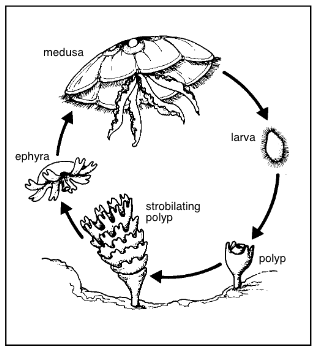
Figure 5. Generalized jellyfish life cycle. (Courtesy of the University of Delaware Sea Grant College Program.)
Jellyfish have a complex life cycle (Figure 5). The adult or medusa stage reproduces sexually, and the fertilized eggs develop into free-swimming larvae. The larvae settle to the bottom and form polyps. The polyps feed on microscopic marine organisms and can reproduce by budding to form other polyps. The polyps eventually develop into strobilating polyps when the polyp body divides into segments. Each segment separates from the polyp and becomes a free-swimming ephyra which then grows to the adult stage. The adults are generally short-lived, but the polyps can live for several years, producing more adults each winter and spring.
Jellyfish are an interesting and colorful part of our marine environment. They are food for sea turtles, spadefish, butterfish, and probably some others we don’t know about. Treat them with respect as we do bees, wasps, and hornets on land. Avoid contact where possible, use common sense, and pack along either alcohol or vinegar and some meat tenderizer when you visit the beach.
This work is partly a result of research sponsored by the Mississippi-Alabama Sea Grant Consortium and NOAA, Office of Sea Grant, Department of Commerce, under Grant No. NA16RG0155-04. MASGP-94-004
Richard Wallace, Extension Marie Specialist, Associate Professor, Fisheries and Allied Aquacultures with Auburn University
Reviewed May 2022, Jellyfish in Alabama, ANR-0928

